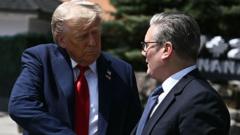In the wake of Trump’s trade war and recent political changes, Canadians are casting votes in a critical election, marking a significant shift in party dynamics, especially between the Liberals and Conservatives, as the outcome could reshape the country's economic future.
Canada's Election Faces Tumultuous Shifts Amid U.S. Political Tensions

Canada's Election Faces Tumultuous Shifts Amid U.S. Political Tensions
As Canadians head to the polls, political dynamics in the nation have drastically shifted due to President Trump's actions, with the Liberal Party emerging stronger against the previously dominant Conservative Party.
---
Canadians are poised to make a significant decision as they head to the polls for a critical federal election on April 28, 2025. This election is seen as crucial not just for determining the nation's leadership but for shaping the response to President Trump’s controversial trade policies and its resulting economic circumstances. Recent surveys indicate a surge in support for the Liberal Party led by Prime Minister Mark Carney over the Conservatives, who were once expected to dominate the electoral landscape.
The political scene has transformed considerably since Trump's trade war began, negatively impacting the Conservative Party's previous standing. Just months ago, the Conservatives, under leader Pierre Poilievre, enjoyed a commanding lead in polls, prioritizing deregulation and minimizing federal intervention. Yet, the resignation of Justin Trudeau and the escalating tariffs from the Trump administration have turned the tide, apparently boosting the Liberals' appeal as a party capable of handling the U.S. threat.
In addition to the two major parties, Canadian voters will also consider the New Democratic Party, the Greens, and the Bloc Quebecois, although their influence remains limited. A notable factor in the upcoming election is the voters' concerns regarding economic stability, affordability of living, and the looming tariffs that may exacerbate job losses and economic downturns.
The incumbent Carney, stepping in after Trudeau’s departure, has positioned himself as a moderate leader emphasizing economic expertise to combat the tumultuous political landscape created by Trump’s administration. Poilievre’s campaign, while utilizing populist themes similar to Trump, has drawn criticism and fears of alienating moderate voters who perceive his alignment with Trump's ideologies as problematic.
Polls across the six Canadian time zones began opening earlier, reflecting the country’s vast expanse. As Canadians prepare to vote, the competition remains tight, with the major parties promising tax breaks aimed at addressing the pressing concern of housing affordability that has become a crisis in many urban centers.
Moreover, Trump’s earlier statements reiterating support for Canadian Conservative candidates have reignited debates on Canada’s sovereignty and independence. Poilievre has vocally rejected Trump’s proclamations that suggest Canada should align more closely with U.S. governance, emphasizing Canadian autonomy.
As the polls draw to a close at 9:30 p.m. Eastern, Canadians await the results that could redefine the country’s political landscape and its response to the pressures exerted by its southern neighbor. The direction the country chooses today will likely influence its economic policies and international relations in the coming years, particularly concerning an unpredictable American administration.
Canadians are poised to make a significant decision as they head to the polls for a critical federal election on April 28, 2025. This election is seen as crucial not just for determining the nation's leadership but for shaping the response to President Trump’s controversial trade policies and its resulting economic circumstances. Recent surveys indicate a surge in support for the Liberal Party led by Prime Minister Mark Carney over the Conservatives, who were once expected to dominate the electoral landscape.
The political scene has transformed considerably since Trump's trade war began, negatively impacting the Conservative Party's previous standing. Just months ago, the Conservatives, under leader Pierre Poilievre, enjoyed a commanding lead in polls, prioritizing deregulation and minimizing federal intervention. Yet, the resignation of Justin Trudeau and the escalating tariffs from the Trump administration have turned the tide, apparently boosting the Liberals' appeal as a party capable of handling the U.S. threat.
In addition to the two major parties, Canadian voters will also consider the New Democratic Party, the Greens, and the Bloc Quebecois, although their influence remains limited. A notable factor in the upcoming election is the voters' concerns regarding economic stability, affordability of living, and the looming tariffs that may exacerbate job losses and economic downturns.
The incumbent Carney, stepping in after Trudeau’s departure, has positioned himself as a moderate leader emphasizing economic expertise to combat the tumultuous political landscape created by Trump’s administration. Poilievre’s campaign, while utilizing populist themes similar to Trump, has drawn criticism and fears of alienating moderate voters who perceive his alignment with Trump's ideologies as problematic.
Polls across the six Canadian time zones began opening earlier, reflecting the country’s vast expanse. As Canadians prepare to vote, the competition remains tight, with the major parties promising tax breaks aimed at addressing the pressing concern of housing affordability that has become a crisis in many urban centers.
Moreover, Trump’s earlier statements reiterating support for Canadian Conservative candidates have reignited debates on Canada’s sovereignty and independence. Poilievre has vocally rejected Trump’s proclamations that suggest Canada should align more closely with U.S. governance, emphasizing Canadian autonomy.
As the polls draw to a close at 9:30 p.m. Eastern, Canadians await the results that could redefine the country’s political landscape and its response to the pressures exerted by its southern neighbor. The direction the country chooses today will likely influence its economic policies and international relations in the coming years, particularly concerning an unpredictable American administration.




















